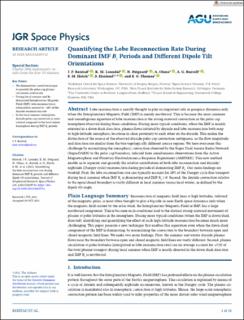| dc.contributor.author | Reistad, Jone Peter | |
| dc.contributor.author | Laundal, Karl Magnus | |
| dc.contributor.author | Østgaard, Nikolai | |
| dc.contributor.author | Ohma, Anders | |
| dc.contributor.author | Burrell, Angeline G. | |
| dc.contributor.author | Hatch, Spencer Mark | |
| dc.contributor.author | Håland, Stein Egil | |
| dc.contributor.author | Thomas, Evan G. | |
| dc.date.accessioned | 2022-01-27T12:32:13Z | |
| dc.date.available | 2022-01-27T12:32:13Z | |
| dc.date.created | 2021-12-22T11:54:51Z | |
| dc.date.issued | 2021 | |
| dc.identifier.issn | 2169-9380 | |
| dc.identifier.uri | https://hdl.handle.net/11250/2888215 | |
| dc.description.abstract | Lobe reconnection is usually thought to play an important role in geospace dynamics only when the Interplanetary Magnetic Field (IMF) is mainly northward. This is because the most common and unambiguous signature of lobe reconnection is the strong sunward convection in the polar cap ionosphere observed during these conditions. During more typical conditions, when the IMF is mainly oriented in a dawn-dusk direction, plasma flows initiated by dayside and lobe reconnection both map to high-latitude ionospheric locations in close proximity to each other on the dayside. This makes the distinction of the source of the observed dayside polar cap convection ambiguous, as the flow magnitude and direction are similar from the two topologically different source regions. We here overcome this challenge by normalizing the ionospheric convection observed by the Super Dual Aurora Radar Network (SuperDARN) to the polar cap boundary, inferred from simultaneous observations from the Active Magnetosphere and Planetary Electrodynamics Response Experiment (AMPERE). This new method enable us to separate and quantify the relative contribution of both lobe reconnection and dayside/nightside (Dungey cycle) reconnection during periods of dominating IMF By. Our main findings are twofold. First, the lobe reconnection rate can typically account for 20% of the Dungey cycle flux transport during local summer when IMF By is dominating and IMF Bz ≥ 0. Second, the dayside convection relative to the open/closed boundary is vastly different in local summer versus local winter, as defined by the dipole tilt angle. | en_US |
| dc.language.iso | eng | en_US |
| dc.publisher | Wiley | en_US |
| dc.rights | Navngivelse 4.0 Internasjonal | * |
| dc.rights.uri | http://creativecommons.org/licenses/by/4.0/deed.no | * |
| dc.title | Quantifying the Lobe Reconnection Rate During Dominant IMF By Periods and Different Dipole Tilt Orientations | en_US |
| dc.type | Journal article | en_US |
| dc.type | Peer reviewed | en_US |
| dc.description.version | publishedVersion | en_US |
| dc.rights.holder | Copyright 2021. The Authors | en_US |
| dc.source.articlenumber | e2021JA029742 | en_US |
| cristin.ispublished | true | |
| cristin.fulltext | original | |
| cristin.qualitycode | 2 | |
| dc.identifier.doi | 10.1029/2021JA029742 | |
| dc.identifier.cristin | 1971420 | |
| dc.source.journal | Journal of Geophysical Research (JGR): Space Physics | en_US |
| dc.relation.project | Norges forskningsråd: 223252 | en_US |
| dc.identifier.citation | Journal of Geophysical Research: Space Physics. 2021, 126 (11), e2021JA029742. | en_US |
| dc.source.volume | 126 | en_US |
| dc.source.issue | 11 | en_US |

